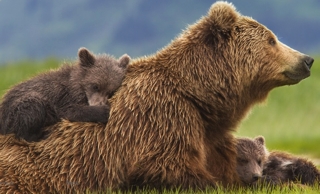 Grade: B-
Grade: B-
Entire family: Yes (but with a grain of salt)
2014, 78 min., Color
DisneyNature
Rated G
Aspect ratio: 1.85:1
Featured audio: English DTS-HD MA 5.1
Includes: Blu-ray, DVD, Digital HD Copy
Bonus features: C-
Trailer
DisneyNature: Bears is an accomplished bit of filmmaking that would have been an unqualified success were it not for narration that periodically insults the intelligence of viewers over the age of eight.
The screenplay and voiceovers are, as my teenage son said, simply “childish” in places—meaning that Bears is clearly aimed at very small children, the way an adult will make funny faces to try to make a toddler laugh. The question is, why? Why narrow your audience like that, when the subject matter has such broad appeal?
The Alaskan cinematography in Bears is breathtaking, and the sometimes extreme photography really adds both epic sweep and intimacy to our understanding of these beautiful creatures. Couple that with perfectly paced scenic construction that builds suspense as we follow a family of Alaskan brown bears from the birth of two cubs through their first year of survival and you have a nature film that’s every bit as good as what Disney produced in the past—or, for that matter, what other studios are producing now.
I suspect that director Alastair Fothergill (The Blue Planet, Earth) is still trying to find the right balance to give Disney what their audiences want: a nature film that’s not as austere as the BBC Earth productions and that has some life, some zest, some whimsy—to imbue the animals with personalities and tell their story in human terms, as the old True-Life Adventures did. So far, Fothergill has done that most successfully with Chimpanzee (2012).
I’m not suggesting that every nature film narrator should sound like David Attenborough, but John C. Reilly really seems an odd choice here. Known primarily for his goofy roles and with a voice that people associate with Cal “Shake ‘n’ Bake” Naughton Jr. from Talladega Nights or Dale from Step Brothers, Reilly is like the reader who wants to entertain children so badly that he goes just a little overboard in his expressiveness and voice modulation. And it’s not just the way the lines are read. The uncredited screenplay for this 78-minute documentary is also to blame.
The old True-Life Adventures brought families together, but who knew how difficult it was to balance personal, whimsical storytelling with a factual, knowledgeable narrative? Disney pulled it off in 1957 with the 75-minute documentary Perri, which followed a female squirrel through a year of her life. The narration was mostly informative but there was also a wink or two from narrator Winston Hibler, whose deep voice and folksy manner provided an easy balance that made this True-Life Adventure work for adults as well as children. Hibler wrote his own scripts, and he walked a careful line between conveying information and infusing the narrative with emotion. I think that his folksiness was the key. Here, Reilly just seems like the uncle who’s around children so little that he talks down to them.
 Still, the cinematography is spectacular, whether we’re watching an avalanche in real time or catching panoramic shots of the bears’ Alaskan wilderness. One of the bonus features shows that photographers didn’t just screw on a long lens and call it a day. They were a lot closer to the bears than you’d think, and Bears provides some remarkable footage—like the opening sequence when we see newborn cubs as young as I’ve ever seen, filmed inside their mountain den. The bears are given names, and Sky mothers her two cubs, Amber and Scout, with love and tough love. Following them we learn about the hibernation pattern of Alaskan brown bears and see that their diet doesn’t just consist of salmon. There are clams to dig so mother’s milk will come in, and other bears and wolves to avoid. It’s all very enlightening and entertaining . . . except for that pesky narration.
Still, the cinematography is spectacular, whether we’re watching an avalanche in real time or catching panoramic shots of the bears’ Alaskan wilderness. One of the bonus features shows that photographers didn’t just screw on a long lens and call it a day. They were a lot closer to the bears than you’d think, and Bears provides some remarkable footage—like the opening sequence when we see newborn cubs as young as I’ve ever seen, filmed inside their mountain den. The bears are given names, and Sky mothers her two cubs, Amber and Scout, with love and tough love. Following them we learn about the hibernation pattern of Alaskan brown bears and see that their diet doesn’t just consist of salmon. There are clams to dig so mother’s milk will come in, and other bears and wolves to avoid. It’s all very enlightening and entertaining . . . except for that pesky narration.
I can envision some nature-lovers picking up this disc and then watching with the mute on and music of their own choosing—and then, when they need an explanation, cranking up the sound and hoping they didn’t catch one of those kindergarten moments. Older children and adults will find the narration annoying, at least in spots, but the cinematography and the story of the bears is so striking that it’s worth the pain.
Bears, which was shot in Alaska’s Katmai National Park, is rated G, and the box notes that Disney Worldwide Conservation Fund has made a contribution to the National Park Foundation “to protect wildlife and America’s national parks.”


Leave a comment